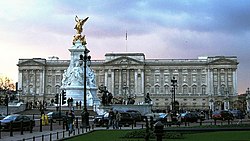England



Official Royal Residences
- St James's Palace – the most senior royal residence in London. It was a principal residence of the monarch from 1702 until 1837. It is the official London residence of some members of the royal family.
- Buckingham Palace – the monarch's principal London residence since 1837. [1]
- Kensington Palace – a royal residence since 1689, but not a principal residence of the monarch since 1760. It is the official London residence of some members of the royal family.
Other Royal Palaces
- Kew Palace – once occupied by some of the family of George II and George III. Buildings now largely destroyed. Kew Gardens and houses now managed by Historic Royal Palaces.
- Hampton Court Palace – a royal residence from 1529 until 1760. Home to certain Grace and favour residents until the last died in 2017. Now managed by Historic Royal Palaces.
- Palace of Westminster – the monarch's official London residence from 1049 until 1530. Now the home of the British Parliament
- Palace of Whitehall – the monarch's official London residence from 1530 until 1698. Mostly demolished, except for the Banqueting House, now managed by Historic Royal Palaces.
Former Royal Palaces
- Eltham Palace – a royal residence from 1305 until 1649. Rebuilt as a house after falling into ruin, it was later used by the Army and is now a museum.
- Apethorpe Palace
- Holdenby Palace – largely demolished
- Richmond Palace – a royal residence from 1497 until 1649, now ruined
- Bridewell Palace – a royal residence from 1515 until 1523, now demolished. [2]
- Palace of Placentia – also known as Greenwich Palace, a royal residence from 1447 until 1660, when it was demolished
- Palace of Beaulieu – a royal residence from 1515 until 1573
- Nonsuch Palace – a royal residence from 1538 until 1683, when it was demolished
- Oatlands Palace
- Canute's Palace, Southampton
- Savoy Palace – now destroyed. Residence
- Clarendon Palace
- Havering Palace
- Kings Langley Palace
- Woking Palace
- Woodstock Palace
- Beaumont Palace
Episcopal Palaces
(see Episcopal palace and Bishop's palace)
- Lambeth Palace – residence of the Archbishop of Canterbury in London
- Old Palace, Canterbury – residence of the Archbishop of Canterbury
- Bishopthorpe Palace – residence of the Archbishop of York
- Bishop's Palace, Lichfield
- Bishop's Palace, Wells
- The Palace, Chichester
Former Episcopal Palaces
- Addington Palace – former residence of the Archbishop of Canterbury near London
- Archbishop's Palace, Maidstone – former residence of the Archbishop of Canterbury
- Mayfield Old Palace – former residence of the Archbishop of Canterbury
- Fulham Palace – former residence of the Bishop of London in London
- Winchester Palace – former residence of the Bishop of Winchester in London
- Bromley Palace – former residence of the Bishop of Rochester near London
- Bishop's Waltham Palace – former residence of the Bishop of Winchester
- Mathern Palace – former residence of the Bishop of Llandaff
- Buckden Towers – former residence of the Bishop of Lincoln
- Archbishop's Palace, York
- Old Palace, Hatfield House
- Bishop's Palace, Ely
- Old Palace, York
- Old Bishop's Palace, Chester
- Bishop's Palace, Lichfield
- Lincoln Medieval Bishop's Palace
- The Old Palace, Worcester
Other Palaces
- Blenheim Palace – residence of the Dukes of Marlborough

